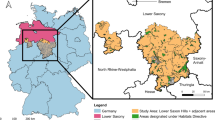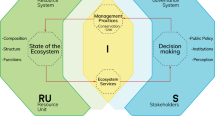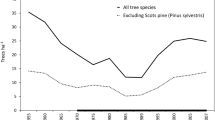Abstract
Beech forests previously covered substantial areas of the continental region of Europe, however, their current distribution is limited to a small percentage of their former yet still potential range. Many beech forests are now protected under the European Union-wide conservation approach of Natura 2000. We analyse the impact of Natura 2000 on the management of beech forests via social science data on management practices gathered from 73 interviews with local stakeholders within nine case study sites in Austria, France, and Germany, and via an ecological analysis of Natura 2000 management plans (MPs). Our data reveals that the Natura 2000 implementation has had little impact on forest management practices. We found that the Natura 2000 network is well known amongst stakeholders, yet the objectives and measures for beech forest protection are usually vaguely defined in the MPs. According to our interviewees, in many cases this vagueness results in a disregard for the MPs, which hence fail to guide the management of the forests protected under Natura 2000. In addition, when ecological thresholds are included in the MPs, they are often below recommendations based on conservation research. In the case of the structural bio-indicator deadwood, the thresholds given by MPs for a favourable site conservation status were significantly lower than those considered within conservation science to be necessary in order to conserve typical beech forest biodiversity. We conclude that while Natura 2000 has raised awareness of the importance of European beech forests for biodiversity conservation, it needs significant additional efforts to make it an effective policy for forest biodiversity conservation.

Similar content being viewed by others
Notes
The concept of a favourable conservation status actually applies to the national and bio-geographical level. Site specific assessments of the conservation status differ from the monitoring of the favourable conservation status. The HD states a series of criteria, which must be fulfilled in order to classify a natural habitat or species as having a favourable conservation status. These are range, area, structure and function (referred to as habitat condition) and future prospects. At the local site level, conservation status is defined as the “degree of conservation of the structure and functions of the natural habitat type concerned and restoration possibilities”. This is what we mean by the concept of a site conservation status, which will be used hereonin.
References
Albuquerque FS, Assuncao-Albuquerque MJT, Cayuela L, Zamora R, Benito BM (2013) European bird distribution is “well” represented by special protected areas: mission accomplished? Biol Conserv 159:45–50
Alexander M (2008) Management planning for nature conservation. A theoretical basis & practical guide. Springer, New York
Alphandery P, Fortier A (2001) Can a territorial policy be based on science alone? The system for creating the Natura 2000 network in France. Sociol Rural 41(3):311–328
Barrett SM (2004) Implementation studies: time for a revival? Personal reflections on 20 years of implementation studies. Public Admin 82(2):249–262
Begehold H, Rzanny M, Flade M (2014) Forest development phases as an integrating tool to describe habitat preferences of breeding birds in lowland beech forests. J Ornithol. doi:10.1007/s10336-014-1110-4
Beichelt T (2009) Deutschland und Europa. Die Europäisierung des politischen Systems. VS Verlag für Sozialwissenschaften, Wiesbaden
BfN—Bundesamt für Naturschutz (2006) Machbarkeitsstudie für eine UNESCO-Weltnaturerbenominierung eines ausgewählten deutschen Buchenwaldclusters. Buchenwaldinstitut e.V
BMU—Bundesministerium für Umwelt, Naturschutz und Reaktorsicherheit (2007) Nationale Strategie zur biologischen Vielfalt. Bundesministerium für Umwelt, Naturschutz und Reaktorsicherheit
BMU—Bundesministerium für Umwelt, Naturschutz und Reaktorsicherheit (2011). Deutsche buchenwälder—Weltnaturerbe der UNESCO, p 36
BNatSchG (2010) Gesetz über Naturschutz und Landschaftspflege (Bundesnaturschutzgesetz) vom 29. Juli 2009 (BGBl. I S. 2542), last modification February 2012 (BGBl. I S. 148)
Bobiec A, von der Burgt H, Meijer K, Zuyderduyn C, Haga J, Vlaanderen B (2000) Rich deciduous forests in Bialowieza as a dynamic mosaic of developmental phases: premises for nature conservation and restoration management. For Ecol Manag 130:159–175
Bohn U, Weber H (2000) Karte der natürlichen vegetation Europas, Maßstab 1:2,5 Mio. Bundesamt für Naturschutz, Bonn
Böhnke-Henrichs A, Lipp T (2009) Implementation of the habitats directive: management planning in Germany. In: Breusta J, Kozova M, Finka M (eds) European landscapes in transformation: challenges for landscape ecology and management, conference proceedings ‘70 years of landscape ecology in Europe’. European IAELE Conference, Salzburg/Bratislava, pp 301–302
Boor GKH (2014) A framework for developing objective and measurable recovery criteria for threatened and endangered species. Conserv Biol 28(1):33–43
Borrass L (2014) Varying practices of implementing the habitats directive in German and British forests. Forest Policy Econom 38:151–160
Bücking W (2003) Naturwaldreservate. Urwald in Deutschland, Bonn, p 66
Bundesamt für Wald (2009) Österreichische Waldinventur—Erhebung (2007–2009). http://bfw.ac.at/rz/wi.home. Accessed on 11 Mar 2013
Bütler R, Angelstam P, Ekelund P, Schlaepfer R (2004) Deadwood threshold values for the three-toed woodpecker presence in boreal and sub-Alpine forest. Biol Conserv 119:305–318
Carnino N (2009) Etat de conservation des habitats d’intérêt communautaire à l’échelle du site. Guide d’application de la méthode d’évaluation des habitats forestiers. SPN—ONF
Carnino N, Touroult J (2010) Evaluation de l’état de conservation des habitats forestiers à l’échelle d’un site natura 2000: Du concept vers un outil pour le gestionnaire. Rev for fr 62(2):127–140
CBD (1992) Convention on biological diversity. Secretariat of the Convention on Biological Diversity, United Nations Environment Programme. http://www.cbd.int/doc/legal/cbd-en.pdf.
Christensen M, Hahn K, Mountford E, Ódor P, Rozenberger D, Diaci J, Standovar T, Wijdeven S, Winter S, Vrska T, Meyer P (2005) Deadwood in European beech (Fagus sylvatica) forest reserves. For Ecol Manag 210:267–282
EC—European Commission (2003) Natura 2000 and forests ‘Challenges and opportunities’. Office for Official Publications of the European Communities, Luxembourg
EC—European Commission (2000) Managing Natura 2000 sites: the provisions of Article 6 of the ‘Habitats’ Directive 92/43/EEC. Office for Official Publications of the European Communities: Luxembourg. Retrieved from: http://ec.europa.eu/environment/nature/natura2000/management/docs/art6/provision_of_art6_en.pdf
Ellwanger G, Schröder E (Eds.) (2006) Management von Natura 2000-Gebieten. Erfahrungen aus Deutschland und ausgewählten anderen Mitgliedsstaaten der Europäischen Union. Naturschutz und Biologische Vielfalt 26, Bonn
EU—European Union (2008) Consolidated version of the treaty on the functioning of the european union. Off J Eur Union C 115:47–199
European Bird Directive (2009) Council Directive 2009/147/EC on the conservation of wild birds replacing the Directive 79/409/EEC of 1979 on the conservation of wild birds
European Commission (2011) Communication from the Commission to the European Parliament, the Council, the European Economic and Social Committee and Committee of the Regions. Our life insurance, our natural capital: an EU biodiversity strategy to 2020 (COM 2011/244 final)
European Commission (2013) Communication from the Commission to the European Parliament, the Council, the European Economic and Social Committee and Committee of the Regions. A new EU Forest Strategy: for forests and the forest-based sector (COM(2013) 659 final)
Forest Europe (2010) Enriching forest biodiversity. Forest Europe is implementing convention on biological diversity provisions. Aas, Norway. Retrieved from: http://www.foresteurope.org/documentos/EnrichingForestBiodiversity_print.pdf
Forest Strategy (2010) The strategic Plan for the CBD. COP10/MOP5 Aichi-Nagoya, Japan. Retrieved from: http://www.cbd.int/cop/cop-10/doc/press/press-briefs-en.pdf
France Nature Environnement (2012) Natura 2000 la Directive à 20 ans. Dossier Press France Nature Environnement. www.fne.asso.fr/com/dossierpresse/dp-150512.pdf. Accessed 5 Feb 2014
Frank G (2002) Brutzeitliche Einnischung des Weißrückenspechtes Dendrocopos leucotos im Vergleich zum Buntspecht Dendrocopos major in montanen Mischwäldern der nördlichen Kalkalpen. Vogelwelt 123:225–239
Habitats Directive (1992) Council Directive 92/43/EEC on the Conservation of natural habitats and of wild fauna and flora
Hanjürgens B, Lübbe-Wolff G (2000) Symbolische Umweltpolitik. Franfurt a.M, Suhrkamp
Harmon ME, Franklin JF, Swanson FJ, Sollins P, Gregory SV, Lattin JD, Anderson NH, Cline SP, Aumen NG, Sedell JR, Lienkaemper GW, Cromack K, Cummins KW (1986) Ecology of coarse woody debris in temperate ecosystems. Adv Ecol Res 15:133–276
Hiedanpää J (2002) European-wide conservation versus local well-being: the reception of the Natura 2000 Reserve Network in Karvia. SW-Finland Landsc Urban Plan 61(2/4):113–123
IGN—National Institute for geographic and forest Information (2011) Prélèvement de bois en forêt et production biologique: des estimations directes et compatibles, LIF n 28
IGN—National Institute for Geographic and Forest Information (2013) Le mémento Édition 2013. La forêt en chiffres et en cartes. http://inventaire-forestier.ign.fr/spip/spip.php?rubrique16. Accessed on 10 Sept 2014
IUCN-UNEP-WWF (1980) World conservation strategy—living resource conservation for sustainable development. International Union for Conservation of Nature and Natural Resources, Gland
Kautz R (2002) Natura 2000—Evaluierung eines naturschutzpolitischen Instruments vor dem Hintergrund des Spannungsverhältnisses zwischen Naturschutzanliegen und Eingriffen in das Eigentumsrecht. Eigenverlag des Instituts für Sozioökonomik der Forst- und Holzwirtschaft, Wien
Kral K, Vrska T, Hort L, Adam D, Samonil P (2010) Developmental phases in a temperate natural spruce-fir-beech forest. Determination by a supervised classification method. Eur J For Res 129:330–351
Kraus D, Krumm F (eds) (2013) Integrative approaches as an opportunity for the conservation of forest biodiversity. European Forest Institute
Krott M (2001) Politikfeldanalyse Forstwirtschaft. Blackwell Wissenschafts-Verlag, Berlin
Kruk RW, De Blust G, Van Apeldoorn RC, Bouwma IM, Sier ARJ (2009) NATURA 2000. Information and communication on the designation and management of Natura 2000 sites. Main Report 2: Organizing the management in 27 EU Member States
Landesgesetzblatt (2005) www.ris.bka.gv.at/Dokumente/Lgbl/LGBL_OB_20051031_110/LGBL_OB_20051031_110.pdf (2005), actualization (2011) www.ris.bka.gv.at/Dokumente/Lgbl/LGBL_OB_20110630_48/LGBL_OB_20110630_48.pdf
Landesgesetzblatt (2013) http://www.noe.gv.at/Umwelt/Naturschutz/Rechtliche-Grundlagen.html. Accessed on 8 Jan 2013
Leibenath M (2008) Legitimacy of biodiversity policies in a multi-level Setting. The case of Germany. In: Keulartz J, Leistra G (eds) Legitimacy in European nature conservation policy: case studies in multilevel governance. Springer, Dordrecht, pp 233–250
Lindenmayer DB, Franklin JF, (2002) Conserving forest biodiversity: a comprehensive multiscaled approach. Island Press, Washington, DC
Louette G, Adriaens D, Adriaens P, Anselin A, Devos K, Sannen K, Van Landuyt W, Paelinckx D, Hoffmann M (2011) Bridging the gap between the Natura 2000 regional conservation status and local conservation objectives. J Nat Conserv 19:224–235
LUBW (2009) Handbuch zur Erstellung von Managementplänen für die Natura 2000-Gebiete in Baden-Württemberg. Version 1.2. http://www.lubw.baden-wuerttemberg.de/
LWF (2004) Arbeitsanweisung zur Erstellung von Managementplänen für Waldflächen in Natura 2000-Gebieten. Retrieved from http://www.lwf.bayern.de/publikationen/daten/sonstiges/p_34539.pdf
MAB (1970) Man and Biosphere programme. Officially launched in 1970 and formally endorsed by the UN Conference on Human Environment in Stockholm in 1972
Mayring P (2000) Qualitative Inhaltsanalyse. Grundlagen und Techniken. Deutscher Studien Verlag, Weinheim
Meiwes KJ, Asche N, Block J, Kallweit R, Kölling C, Raben G, von Wilpert K (2008) Potenziale und Restriktionen der Biomassenutzung im Wald. AFZ-Der Wald 10–11:598–603
Michel A, Winter S (2009) Tree microhabitat structures as indicators of biodiversity in Douglas-fir forests of different stand ages and management histories in the Pacific Northwest. USA For Ecol Manag 257:1453–1464
Mills LS, Lindberg MS (2002) Sensitivity analysis to evaluate the consequences of conservation actions. In: Beissinger SR, McCullough DR (eds) Population viability analysis. University of Chicago Press, Chicago, pp 338–366
Moning C, Bussler H, Müller J (2009) Ökologische Schlüsselwerte in Bergmischwäldern als Grundlage für eine nachhaltige Forstwirtschaft. Wissenschaftliche Reihe des nationalpark Bayerischer Wald 19:1–102
Morris RKA, Bennett T, Blyth-Skyrme R, Barham PJ, Ball A (2014) Managing Natura in the marine environment—an evaluation of the effectiveness of ‘management schemes’ in England. Ocean Coastal Manag 87:40–51
Müller J (2005) Waldstrukturen als Steuergröße für Artengemeinschaften in kolinen bis submontanen Buchenwäldern. PhD thesis Technische Universität München, p 197
Müller J, Bütler R (2010) A review of habitat thresholds for deadwood: a baseline for management recommendations in European forests. Eur J For Res 129:981–992
Oberösterreichische Landesregierung (2011): Verordnung der Oö. Landesregierung, mit der das Gebiet “Ettenau I” in den Gemeinden St. Radegund und Ostermiething als Naturschutzgebiet festgestellt und ein Landschaftspflegeplan für dieses Gebiet erlassen wird
Paillet Y, Bergès L, Hjältén J, Ódor P, Avon C, Bernhardt-Römermann M, Bijlsma RJ, de Bruyn L, Fuhr M, Grandin U, Kanka R, Lundin L, Luque S, Magura T, Matesanz S, Mészáros I, Sebastià MT, Schmidt W, Standovár T, Tóthmérész B, Uotila A, Valladares F, Vellak K, Virtanen R (2010) Biodiversity differences between managed and unmanaged forests: meta-analysis of species richness in Europe. Conserv Biol 24(1):101–112
Paluch JG (2007) The spatial pattern of a natural European beech (Fagus sylvatica L.)-silver fir (Abies alba Mill.)-forest. A patch-mosaic perspective. For Ecol Manag 253:161–170
PAN & ILÖK—Planungsbüro für angewandten Naturschutz GmbH & Institut für Landschaftsökologie, AG Biozönologie (2009) Bewertung des Erhaltungszustandes der Lebensraumtypen nach Anhang I der Fauna-Flora-Habitat-Richtlinie in Deutschland. Überarbeitete Bewertungsbögen der Bund-Länder-Arbeitkreise als Grundlage für ein bundesweites FFH-Monitoring erstellt im Rahmen des F + E-Vorhabens “Konzeptionelle Umsetzung der EU-Vorgaben zum FFH-Monitoring und Berichtspflichten in Deutschland”
Pülzl H, Treib O (2007) Implementing Public Policy. In: Fischer F, Miller GJ, Sidney MS (eds) Handbook of public policy analysis—theory, politics, and methods. CRC Press, Boca Raton, London, New York, pp 89–107
Rametsteiner E, Mayer P (2004) Sustainable forest management and Pan-European forest policy. Ecol Bull 51:51–57
Ranius T, Niklasson M, Berg N (2009) Development of tree hollows in pedunculate oak (Quercus robur). For Ecol Manag 257(1):303–310
Rauschmayer F, van den Hove S, Koetz T (2009) Participation in EU biodiversity governance: how far beyond rhetoric? Environ Plan C 27(1):42–58
Rosenkranz L, Wippel B, Seintsch B (2012) FFH-Impact. Work report 04/05/06/2012. Johann Heinrich von Thünen-Institut
Samuelsson J, Gustafsson L, Ingelog T (1994) Dying and dead trees—a review of their importance for biodiversity. Swedish Threatened Species Unit, Uppsala, p 109
Sauer A (2006) Europäische Naturschutzpolitik. Oekom Verlag, München
Schmitz F, Polley H, Hennig P, Schwitzgebel F, Kriebitzsch WU (2004) Die zweite Bundeswaldinventur – BWI2: Das Wichtigste in Kürze. Bundesministerium für Verbraucherschutz, Ernährung und Landwirtschaft, Bonn
Schofield J (2004) A model of learned implementation. Public Admin 82:283–308
Seintsch B, Weimar H (2013) Holzbilanzen 2010 bis 2012 für die Bundesrepublik Deutschland. Thünen Working Paper 9
Souheil H, Germain L, Boivin D, Douillet R et al (2009) Guide méthodologique d’élaboration des documents d’objectifs Natura 2000. Atelier Technique des Espaces Naturels, Cahier Technique N82: Montpelliers
Statistisches Bundesamt (2014) https://www.destatis.de/DE/ZahlenFakten/Wirtschaftsbereiche/LandForstwirtschaftFischerei/WaldundHolz/Tabellen/GesamteinschlagHolzartengruppen.html
StatistischesBundesamt (2009) Statistical yearbook. Statistisches Jahr, Wiesbaden, p 753
Stütz B (2004) Der politische Prozess zur Erstellung von Managementplänen in Natura 2000-Gebieten in Niederösterreich, Wien
Van Apeldoorn RC, Kruk RW, Bouwma IM, Ferranti F, Blust G de, Sier ARJ (2009) Natura 2000—information and communication on the designation and management of Natura 2000 sites. Main Report 1. Alterra: Wageningen
van der Zouwen, M, van den Top M (2001) European nature conservation policies in the Netherlands - a pioneer unable to implement its own ambitions. Radboud University Nijmegen: www.ru.nl/publish/pages/515103/2002-10.pdf. Accessed on 18 Sept 2012
Vanderwel MC, Malcolm JR, Smith SM (2009) Long-term snag and downed woody debris dynamics under periodic surface fire, fire suppression, and shelterwood management. Can J For Res 39(9):1709–1721
von Drachenfels O (2011) Methodische Überlegungen zur Bewertung des Erhaltungszustands von FFH-Lebensraumtypen. Nat Landsch 86:08
Winkel G (2008) Schutz von Wäldern außerhalb von Schutzgebieten. Zur Rolle von Segregation und Integration im globalen Waldnaturschutz. Nat Landschaft 4:162–164
Winter S (2012) Forest naturalness assessment as a component of biodiversity monitoring and conservation management. Int J For. doi:10.1093/forestry/cps004
Winter S, Brambach F (2011) Determination of a common forest life-cycle assessment method for biodiversity evaluation. For Ecol Manag 262(12):2120–2132. doi:10.1016/j.foreco.2011.07.036
Winter S, Seif J (2011) Bewertungskriterien zum Erhaltungszustand von Natura-2000-Buchenwald-Lebensraumtypen—Vergleich verschiedener Bundesländer und Umsetzung in Managementplänen. Nat Landsch Plan 43(4):101–110
Winter S, Begehold H, Vrska T (2013) Forest naturalness as a key to forest biodiversity preservation. In: Kraus D, Krumm F (eds) Integrative approaches as an opportunity for the conservation of forest biodiversity. European Forest Institute, Freiburg, pp 52–61
Acknowledgments
The data used for this paper was collected within the scope of the European BeFoFu project (www.befofu.org/). BeFoFu is funded by national funding agencies. For this paper, we are grateful to the Austrian Wissenschaftsfond, the French Agence Nationale de la Recherche and the German Federal Ministry of Education and Research for their support. In addition, we are grateful to the experts and stakeholders who devoted their time for the interviews, and to two anonymous reviewers for their helpful comments. Finally, we wish to thank Amelia Pope for the final proof reading.
Author information
Authors and Affiliations
Corresponding author
Appendix
Appendix
List of interview questions
The local actors
-
1.
Data about the interviewee
-
−
What is your main activity?
-
−
Are you the member of an institution or a group related to forest management, nature conservation and/or Natura 2000?
-
−
How have you been involved in the N2000 sites’ implementation process?
-
−
Describe your view on the Habitat Directive and Natura 2000.
-
−
What do you think of the N2000 network and its in situ implementation?
-
−
How do you understand it?
-
−
-
2.
Who are the other actors involved in the implementation of Natura 2000?
-
3.
What was their position before the implementation and what is their current position?
Practices related to the N2000 site’s local implementation
-
4.
How far and in which way did you participate in the discussions around the management plan?
-
5.
How does the management plan take into consideration…
-
−
your forest management practices (for foresters, hikers, hunters,…)?
-
−
activities related to forest concerning the town/village (to mayors)?
-
−
-
6.
How do the two (forest management practices and interests of town) correspond?
-
7.
Which changes do you suggest for the MP?
-
8.
How do you plan to manage your forest with this management plan?
Biodiversity
-
9.
In your personal opinion, what are the main reasons for the nomination of this N2000 area?
-
10.
What is your opinion about all the discourses around biodiversity and nature protection?
-
How important is climate change?
-
Did it have an effect on the management/policy?
-
Why/why not?
-
If not, should it?
-
-
-
11.
Did you consider climate change issues in your management practices?
-
12.
How important is the issue of biodiversity and its conservation in your view?
Economic impact
-
13.
What is the economic impact of Natura 2000 on your enterprise?
-
−
Costs: monetary expenses, use of resources, time
-
−
Benefits of Natura 2000: additional income, subsidies, private sources of funding
-
−
-
14.
How do you fund the cost caused by N2000?
-
Which sources of funding did you apply for?
-
Which applications were successful?
-
Which sources of funding do you know? Which do you consider accessing? Why?
-
Which do you not consider? Why not?
-
Rights and permissions
About this article
Cite this article
Winter, S., Borrass, L., Geitzenauer, M. et al. The impact of Natura 2000 on forest management: a socio-ecological analysis in the continental region of the European Union. Biodivers Conserv 23, 3451–3482 (2014). https://doi.org/10.1007/s10531-014-0822-3
Received:
Revised:
Accepted:
Published:
Issue Date:
DOI: https://doi.org/10.1007/s10531-014-0822-3




